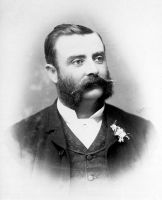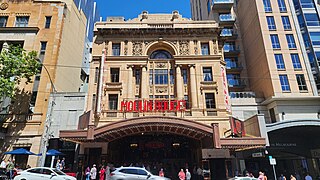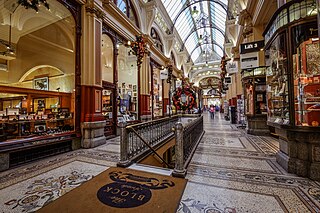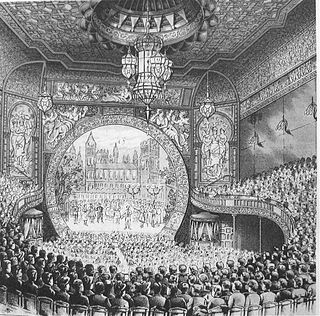
The Gaiety Theatre was a theatre in Melbourne, Australia, which operated from 1889 to 1930, when it became the Roxy movie theatre until it was demolished in 1934.

The Gaiety Theatre was a theatre in Melbourne, Australia, which operated from 1889 to 1930, when it became the Roxy movie theatre until it was demolished in 1934.

The history of the Gaiety is connected to that of the Bijou Theatre at 217-223 Bourke Street, which began as the Academy of Music in 1876, set at the very rear of the site, accessed via the Victoria Arcade. Renamed the Bijou in 1880, [1] [2] it was bought in 1880 by John Alfred Wilson (c1833-1915), who had made a fortune in gold mining, and had a wide range of business interests. [3] In 1888-9 Wilson bought the adjacent site and built the Palace Hotel, with a large dining room at ground level, both accessed from the Victoria Arcade. [4] In 1890 the Bijou was destroyed by fire, and immediately rebuilt to a larger scale, and at the same time the Palace Hotel dining room was refitted as a theatre, called the Gaiety. [1] The architect for both was George Johnson.
After a succession of lessees, [5] in 1915 the freehold of the Palace Hotel and Gaiety, along with the lease of the Bijou, was bought by theatrical entrepreneur Ben Fuller. By this time, the Gaiety often showed films as well as live acts, and in the 1920s was operated by Hoyts as the New Gaiety. [6] In 1930, it was refurbished for talking pictures and renamed the Roxy movie theatre, as part of plan for a larger development of the two theatres. [7] The hotel was closed in 1929, and having weathered the Great Depression, Fullers demolished the Bijou, the Roxy and the hotel for his grand scheme in 1934, which never eventuated. Instead, the site was subdivided, with the section once occupied by the front part of the arcade was sold to the Commonwealth Bank in 1938 for a 10 storey office building, [8] completed in 1941, while the site of Bijou theatre itself and of the Palace Hotel and Gaiety Theatre remained vacant and used as a carpark.

Bourke Street is one of the main streets in the Melbourne central business district and a core feature of the Hoddle Grid. It was traditionally the entertainment hub of inner-city Melbourne, and is now also a popular tourist destination and tram thoroughfare.

The HOYTS Group of companies in Australia and New Zealand includes HOYTS Cinemas, a cinema chain, and Val Morgan, which sells advertising on cinema screens and digital billboards.

Joseph Reed was a Cornish-born architect in Melbourne, Australia in the Victorian era. He established his practice in 1853, which through various partnerships and name changes, continues today as Bates Smart, one of the oldest firms continually operating in Australia.

William Pitt was an Australian architect and politician. Pitt is best known as one of the outstanding architects of the "boom" era of the 1880s in Melbourne, designing some of the city's most elaborate High Victorian commercial buildings. He worked in a range of styles including Gothic Revival, Italianate, French Second Empire, and his own inventive eclectic compositions. He had a notable second career after the crash of the 1890s, becoming a specialist in theatres and industrial buildings.
Nahum Barnet was an architect working in Melbourne, Victoria, Australia during the Victorian and Edwardian periods, best known for his extensive legacy of commercial buildings in Melbourne's CBD, as well as his last design, the Melbourne Synagogue.

A coffee palace was an often large and elaborate residential hotel that did not serve alcohol, most of which were built in Australia in the late 19th century.
Australian non-residential architectural styles are a set of Australian architectural styles that apply to buildings used for purposes other than residence and have been around only since the first colonial government buildings of early European settlement of Australia in 1788.

The Regent Theatre is an historic former picture palace built in 1929, closed in 1970, and restored and reopened in 1996 as a live theatre in Collins Street, in the city of Melbourne, Australia. It is one of six city theatres collectively known as Melbourne's East End Theatre District. Designed by Cedric Heise Ballantyne in an ornately palatial style, with a Gothic style lobby, Louis XVI style auditorium, and the Spanish Baroque style Plaza Ballroom in the basement, it is listed by the National Trust of Australia and is on the Victorian Heritage Register.

The Block Arcade is a historic shopping arcade in the central business district of Melbourne, Victoria, Australia. Constructed between 1891 and 1893, it is considered one of the late Victorian era's finest shopping arcades and ranks among Melbourne's most popular tourist attractions.

The Palace Theatre was an entertainment venue located in Melbourne, Australia. First built for live theatre in 1912, it was also used as a cinema and for live music. It was demolished except for its facade in 2020 after much community opposition, to be replaced by a hotel.

The Melbourne central business district in Australia is home to numerous lanes and arcades. Often called "laneways", these narrow streets and pedestrian paths date mostly from the Victorian era, and are a popular cultural attraction for their cafes, bars and street art.

The Bijou Theatre (1882–1943) in Boston, Massachusetts, occupied the second floor of 545 Washington Street near today's Theatre District. Architect George Wetherell designed the space, described by a contemporary reviewer as "dainty." Proprietors included Edward Hastings, George Tyler, and B.F. Keith. Around the 1900s, it featured a "staircase of heavy glass under which flowed an illuminated waterfall." The Bijou "closed 31 December 1943 and was razed in 1951." The building's facade still exists. It is currently a pending Boston Landmark by the Boston Landmarks Commission.
The Tivoli Theatre was an important venue in Melbourne's East End Theatre District, located at 249 Bourke Street near Swanston Street. The first theatre on the site opened in 1866, rebuilt in 1872 as the Prince of Wales Opera House, rebuilt again in 1901 as the New Opera House, and renamed the Tivoli in 1914 when it joined the Tivoli circuit. The theatre closed in 1966.

Henry Eli White, also known as Harry White, was a New Zealand-born architect best known for the many theatres and cinemas he designed in New Zealand and Australia in the 1910s and 1920s. Many of the major surviving historic venues in the two countries are White designs, including the St. James Theatre, Wellington, St. James Theatre, Auckland, the Capitol Theatre and State Theatre in Sydney, and the Palais Theatre and the interiors of the Princess Theatre and Athenaeum Theatre in Melbourne. He also designed the City Hall and the attached Civic Theatre in Newcastle, New South Wales.

Roxy Theatre is a heritage-listed former theatre at 65–69 George Street, Parramatta, City of Parramatta, New South Wales, Australia. It was designed by Moore & Dyer in association with Herbert & Wilson. It is also known as Roxy Spanish Theatre, Hoyts Roxy Centre, Village Roxy 3 and The Roxy. It was added to the New South Wales State Heritage Register on 2 April 1999.
The Hotel Australia was a former hotel in Melbourne, Australia. The hotel was built in 1939 on the site of the former Cafe Australia, and was demolished in 1989.

The first theatre on the site at 217-223 Bourke Street, Melbourne was the Victorian Academy of Music, built for Samuel Aarons, which opened with a performance by Ilma de Murska on 6 November 1876. Seating about 1600, it was designed by Reed & Barnes, and located on a deep site, with the theatre at the rear, located above a wide passageway running through the site, called the Victoria Arcade. The arcade featured billiard and refreshment rooms, and access to the theatre was from a grand stair off Bourke Street, as well as stairs running off the arcade.
George Benjamin William Lewis commonly referred to as G. B. W. Lewis, or G. B. Lewis, was an English circus performer, later a circus and theatre entrepreneur in Australia. He married in 1864 the actress and playwright Rose Edouin.
The National Amphitheatre was a boxing stadium and entertainment venue at 73–75 Castlereagh Street, Sydney, New South Wales. Rebuilt as a theatre for vaudeville productions by the Fuller brothers, it was refurbished and renamed several times.